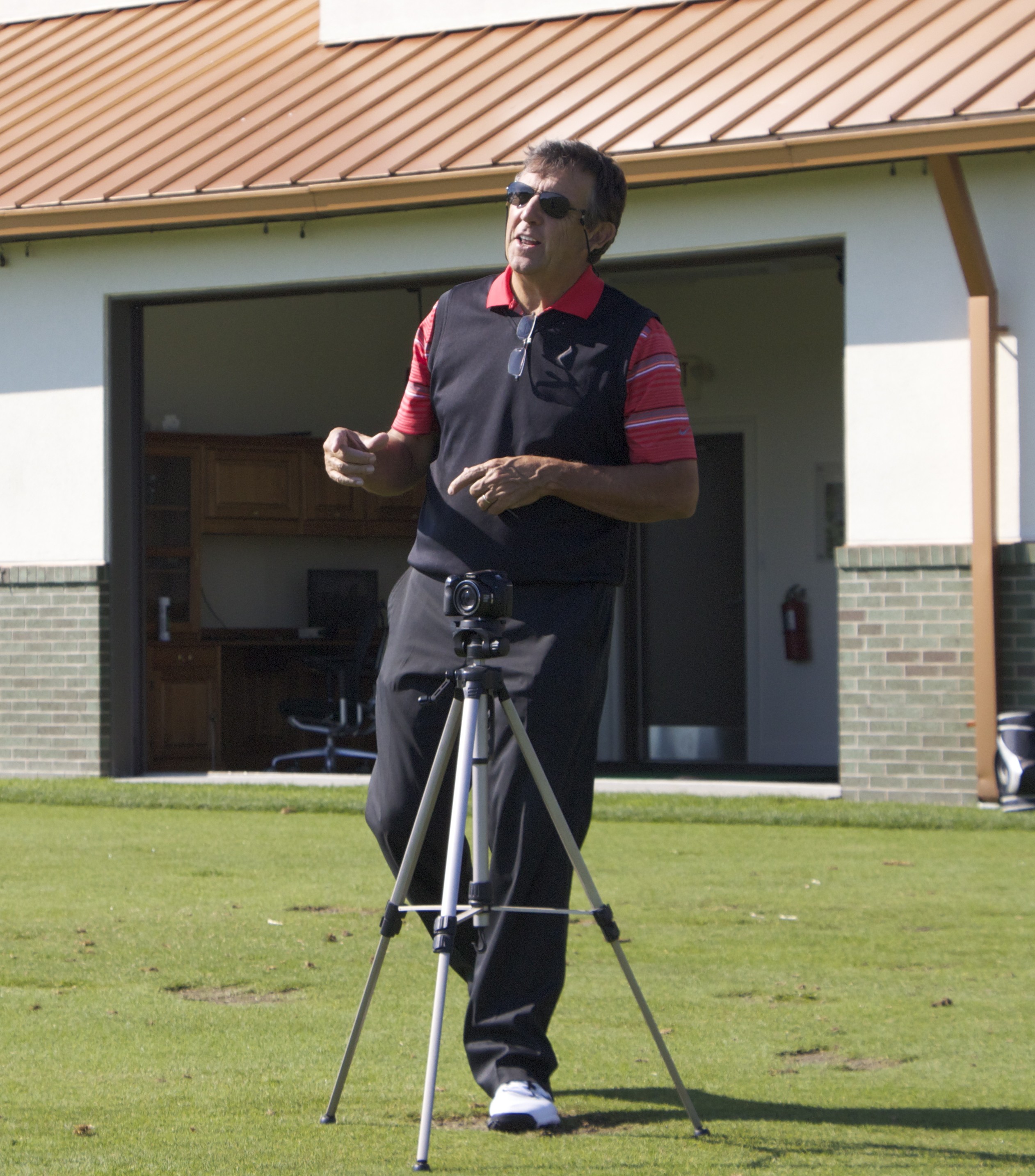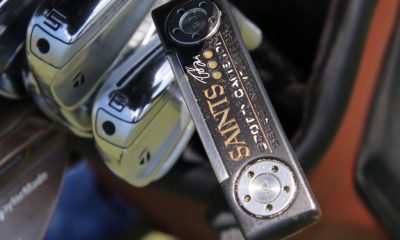Instruction
How to “bottom out” your scores

You can learn a lot about your swing by starting at the bottom. Every swing has a low point and knowing yours can help you understand a lot about how you got there.
There are three possibilities for the low point:
- Too far behind
- Just right
- Too far in front of the golf ball.
The correct low point is a few inches in front of the golf ball for most shots. A swing bottom that is too far behind the ball causes golfers to hit fat shots. A swing bottom that is too far in in front of the ball causes golfers to hit topped or thin shots.
But to fully understand the importance of where the swing bottoms out, you have to consider the concept of angle of attack. You can hit behind the ball in two ways: with too shallow of an angle OR too steep of an angle. For this reason, there can be no discussion of fat shots without discussing swing width.
A good example to help you understand the swing bottom is that if you took a hula-hoop and stood it upright, there would one small point at the bottom that touched the ground. I call that a very narrow swing bottom. But if you took that hula-hoop and tilted the top portion closer to the ground, there would be several points at the bottom that touched the ground. I call that a wide bottom.
The differences in swing width have a lot to do with the different planes on which golfers swing. Flat swing planes tend to have wide bottoms and upright swing planes have very narrow bottoms. Flat swings keep the golf club along the ground longer, while upright swings are “in and out” of the ground for a shorter period of time. But both swings can bottom out too soon.
When the swing bottom is too far behind golf ball because of too wide an arc, you need to make a steeper swing. If the swing bottom is too far behind the golf ball because of too of narrow an arc, you need to make a more shallow swing. (Remember: steep is narrow and shallow is wide).
How can you tell the difference between too steep and too shallow? Just look at your divots. Are they burial grounds or thin slices of bacon? They can both hit behind the ball, but one just brushes the grass behind the ball and one digs trenches.
Let’s tackle fixing a swing with too shallow of a bottom first. You need to swing more steeply into the ball, so try the following:
- A narrower stance at address, with a bit more weight on your left side.
- A more centered pivot in the backswing
- A more upright backswing
- A more narrow pull down of the golf club, which feels like more “lag”
- An emphasis on turning through the golf ball
If you are too steep:
- A wider stance at address with a little more weight on the right side
- A bigger, wider shoulder turn in the backswing
- A flatter swing plane going back
- An earlier, wider release coming down
- An emphasis on swinging the arms past the body and staying behind it.
Remember narrow, steep swings can be late into impact, and flatter wider swings can be earlier into the ball. Let me offer a few examples: If you were watch Sergio Garcia, who has a very wide arc in his downswing after his vertical drop, you would notice that he relies on a lot of lag to narrow the width of his swing. This helps him reach the low point just in front of the ball. Tom Watson has a much earlier releaser of the club to widen his arc due to a very upright, and therefore narrow motion. Both are great players, but they have very different release points because of the different widths of their swings.
Your release is a function of your width, plane and angle into the golf ball. Your goal should be finding a compatible move that will bottom out consistently in the same place. The tips above might help you do just that!
As always, feel free to send a swing video to my Facebook page and I will do my best to give you my feedback.
Dennis Clark is a PGA Master Professional at Nemacolin Woodlands Resort in Farmington, Pa., and Marriott Marco Island Resort in Naples, Fla. He has been a professional for over 25 years. You can learn more about Dennis on his website, http://www.dennisclarkgolf.com
You can read a GolfWRX feature story and video about Dennis by clicking here.
Click here for more discussion in the forums.
- LIKE2
- LEGIT0
- WOW1
- LOL0
- IDHT0
- FLOP0
- OB0
- SHANK0
Instruction
Clement: Laid-off or perfect fade? Across-the-line or perfect draw?

Some call the image on the left laid off, but if you are hitting a fade, this could be a perfect backswing for it! Same for across the line for a draw! Stop racking your brain with perceived mistakes and simply match backswing to shot shape!
- LIKE0
- LEGIT0
- WOW0
- LOL0
- IDHT0
- FLOP0
- OB0
- SHANK1
Instruction
The Wedge Guy: The easiest-to-learn golf basic

My golf learning began with this simple fact – if you don’t have a fundamentally sound hold on the golf club, it is practically impossible for your body to execute a fundamentally sound golf swing. I’m still a big believer that the golf swing is much easier to execute if you begin with the proper hold on the club.
As you might imagine, I come into contact with hundreds of golfers of all skill levels. And it is very rare to see a good player with a bad hold on the golf club. There are some exceptions, for sure, but they are very few and very far between, and they typically have beat so many balls with their poor grip that they’ve found a way to work around it.
The reality of biophysics is that the body moves only in certain ways – and the particulars of the way you hold the golf club can totally prevent a sound swing motion that allows the club to release properly through the impact zone. The wonderful thing is that anyone can learn how to put a fundamentally sound hold on the golf club, and you can practice it anywhere your hands are not otherwise engaged, like watching TV or just sitting and relaxing.
Whether you prefer an overlap, interlock or full-finger (not baseball!) grip on the club, the same fundamentals apply. Here are the major grip faults I see most often, in the order of the frequency:
Mis-aligned hands
By this I mean that the palms of the two hands are not parallel to each other. Too many golfers have a weak left hand and strong right, or vice versa. The easiest way to learn how to hold the club with your palms aligned properly is to grip a plain wooden ruler or yardstick. It forces the hands to align properly and shows you how that feels. If you grip and re-grip a yardstick several times, then grip a club, you’ll see that the learning curve is almost immediate.
The position of the grip in the upper/left hand
I also observe many golfers who have the butt of the grip too far into the heel pad of the upper hand (the left hand for right-handed players). It’s amazing how much easier it is to release the club through the ball if even 1/4-1/2″ of the butt is beyond the left heel pad. Try this yourself to see what I mean. Swing the club freely with just your left hand and notice the difference in its release from when you hold it at the end of the grip, versus gripping down even a half inch.
To help you really understand how this works, go to the range and hit shots with your five-iron gripped down a full inch to make the club the same length as your seven-iron. You will probably see an amazing shot shape difference, and likely not see as much distance loss as you would expect.
Too much lower (right) hand on the club
It seems like almost all golfers of 8-10 handicap or higher have the club too far into the palm of the lower hand, because that feels “good” if you are trying to control the path of the clubhead to the ball. But the golf swing is not an effort to hit at the ball – it is a swing of the club. The proper hold on the club has the grip underneath the pad at the base of the fingers. This will likely feel “weak” to you — like you cannot control the club like that. EXACTLY. You should not be trying to control the club with your lower/master hand.
Gripping too tightly
Nearly all golfers hold the club too tightly, which tenses up the forearms and prevents a proper release of the club through impact. In order for the club to move back and through properly, you must feel that the club is controlled by the last three fingers of the upper hand, and the middle two fingers of the lower hand. If you engage your thumbs and forefingers in “holding” the club, the result will almost always be a grip that is too tight. Try this for yourself. Hold the club in your upper hand only, and squeeze firmly with just the last three fingers, with the forefinger and thumb off the club entirely. You have good control, but your forearms are not tense. Then begin to squeeze down with your thumb and forefinger and observe the tensing of the entire forearm. This is the way we are made, so the key to preventing tenseness in the arms is to hold the club very lightly with the “pinchers” — the thumbs and forefingers.
So, those are what I believe are the four fundamentals of a good grip. Anyone can learn them in their home or office very quickly. There is no easier way to improve your ball striking consistency and add distance than giving more attention to the way you hold the golf club.
More from the Wedge Guy
- The Wedge Guy: Golf mastery begins with your wedge game
- The Wedge Guy: Why golf is 20 times harder than brain surgery
- The Wedge Guy: Musings on the golf ball rollback
- LIKE87
- LEGIT13
- WOW6
- LOL1
- IDHT0
- FLOP4
- OB1
- SHANK8
Instruction
Clement: Stop ripping off your swing with this drill!

Not the dreaded headcover under the armpit drill! As if your body is defective and can’t function by itself! Have you seen how incredible the human machine is with all the incredible feats of agility all kinds of athletes are accomplishing? You think your body is so defective (the good Lord is laughing his head off at you) that it needs a headcover tucked under the armpit so you can swing like T-Rex?
- LIKE0
- LEGIT2
- WOW2
- LOL0
- IDHT0
- FLOP0
- OB0
- SHANK2
-

 19th Hole2 weeks ago
19th Hole2 weeks agoDave Portnoy places monstrous outright bet for the 2024 Masters
-

 19th Hole4 days ago
19th Hole4 days agoJustin Thomas on the equipment choice of Scottie Scheffler that he thinks is ‘weird’
-

 19th Hole2 weeks ago
19th Hole2 weeks agoTiger Woods arrives at 2024 Masters equipped with a putter that may surprise you
-

 19th Hole4 days ago
19th Hole4 days ago‘Absolutely crazy’ – Major champ lays into Patrick Cantlay over his decision on final hole of RBC Heritage
-

 19th Hole2 weeks ago
19th Hole2 weeks agoTwo star names reportedly blanked Jon Rahm all week at the Masters
-

 19th Hole1 week ago
19th Hole1 week agoReport: LIV Golf identifies latest star name they hope to sign to breakaway tour
-

 19th Hole2 weeks ago
19th Hole2 weeks agoNeal Shipley presser ends in awkward fashion after reporter claims Tiger handed him note on 8th fairway
-

 19th Hole1 week ago
19th Hole1 week agoBrandel Chamblee has ‘no doubt’ who started the McIlroy/LIV rumor and why
















Andreas
Oct 17, 2012 at 3:13 pm
Sorry for a daft question but english is not my native language.
Did i understood it correctly if a deep trench divot indicate a steep angle of attack?
Dennis Clark
Dec 26, 2012 at 7:08 pm
sorty for the late reply but..,yes a deep divot often means too steep an angle of attack. Thx, DC
dennis
Sep 16, 2012 at 3:17 pm
WVUfore: Hit a LOT of balls: Draw a line in the dirt, put your club on it at address, and try to bottom out if front of it every time. FELL the sensation of what you’re doing.
WVUfore
Sep 16, 2012 at 2:35 pm
Once you find your swing bottom, do you recommend any drills to help consistently find that point. Do you have the same swing bottom with an iron as you may with a wedge?
Anne
Sep 16, 2012 at 11:34 am
ALWAYS ENJOY YOUR TIPS!!
THANKS FOR STAYING IN TOUCH!!
Bob and Anne Longwell